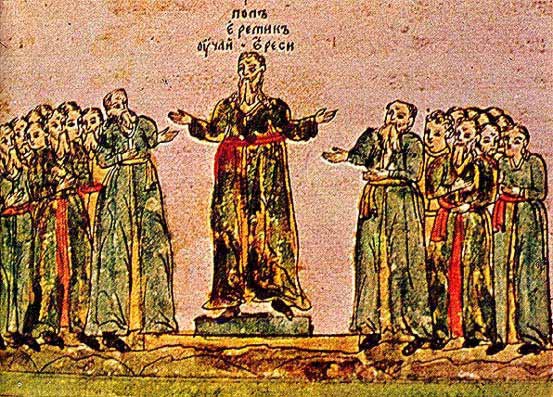Table of Contents
Prologue
Simeon expanded the Bulgarian Empire towards both the Adriatic and the Black Sea. Its northern frontier coincided with the Danube and its southern one passed by Servia, Veria, Serres, and Edirne. At the beginning of the 10th century these points marked the limit of Bulgarian penetration.
It is impossible for an ascent to last forever … The army was exhausted, agriculture had deteriorated, production was minimized and the treasury drained. The differentiation between the rich and powerful lords, the clerical and secular nobility and those who were simply “the poor” was on the increase. The ethnic division between the north and south which had existed for more than a hundred years added to the problems of the state’s continued existence. In Thrace the settlement by the iconoclastic Armenians and Syrians “proved in Paulician heresy” continued. Constantinople had long been suffering because of their presence ever since these “triple-damned and ungodly” Paulicians had in the 7th century formed their state in the upper course of the Euphrates, a state nourished with the Manichaeism of good and evil, of the gap between the soul and the material, between the spirit and the body. The dualistic ideas of the newcomers, frontiersmen from the east, soon put their roots down in the but recently christianized pagan soil.
Towards the middle of the 10th century Macedonia became the centre of the new, Bogomil, cosmogony, a doctrine original in its eclecticism. Because of its origin this doctrine is frequently called the neo-Manichaean system, although a “system” requires a more developed organization of dogma. The teaching of Priest Bogomil is the most striking religious, ideological and sociological phenomenon of the Middle Ages.
Doctrine
It so happens that we should learn about the Bogomil doctrine and canon from the writings of their adversaries, the ecclesiastical writing about these heretics. The strength of the evidence against this “heresy” depended solely on the skill and persuasiveness of those who judged and at the same time condemned it and they, the guardians of the faith, were without exception extremely skilled.
Wishing to deal with this “new heresy”, the Bulgarian czar Peter, according to his correspondence with Patriarch Theophilact, summoned a council. The sources do not speak of the meeting but only of the decisions reached: a collection of anathemas, or comminatory formulae. These are the oldest documents on the Bogomils. The most exhaustive and valuable records on “the shameless, who believe Satan to be the elder son of God” are those of the Presbyter Cosmas. The polemic treatise Sermon against the newly ensued heresy which was designed to be anti-Bogomil is, without cumbersome learnedness, a laudation of the “universal faith and the earthly order of God’s providence”. The introduction to the chapter entitled On Faith also includes a list of the anathemas. What a paradox, that the anathemas and fulminations anti or contra the Bogomils should be the most extensive knowledge pro the Bogomils, pro their teaching, canon and doctrine. Like their ancestors from the East, the Bogomils, who interpreted the visible as a creation of evil and repudiated all rituals, cults and churches, revered only the pure and spiritual, the stringent and ascetic and their own ladder to spiritual baptism. The “perfect – the aged, the guests and the elders” were entrusted with the leadership and were followed by the common believers, “listeners to and servants of the chosen”.
The apocryphal literature created by the Bogomils complements the picture we have of them. In the pseudo-Bogomil Secret Book, the story of Mary, begotten of David’s seed and born of a goose, out of whose ear Jesus was born, unites the oriental, the Orphic, the pagan – both Antique and Slavonic – and the Early Christian mythological heritage. The syncretism of the Bogomils is based not only on affirmative by also on negative injunctions. Mary is not only a genesis, a demiurge, a life-giver, a Urania, a supreme female deity and a beginning of all existence. She is all of these together were it not that, according to the chosen apocrypha, she is, like Satan himself, a fallen angel. With such a composite image it is inevitable that she should not be revered.
The Bogomils considered duality to be an integral part of man himself his body a shell possessed by evil and his soul striving towards the inalienable Heavens. Deeply pessimistic, the Bogomil doctrine, uncompromising towards the entire earthly creation, rose against all order and all churches. It profited from the crises and problems of the Middle Ages, spreading and growing deeper roots.
Epilogue
The Bogomil movement, under various names – Patarenes, Babuni, Cathari, Albigenses, the shorn ones – spread from Armenia to the south of France.
In the 12th century the Byzantine Empire still had problems with the Bogomils: the leader of the heretics, Basil, and his brethren, were burned at the stake, by order of Alexius I Comnenius. At the same time, the Bosnian Patarenes, with the open support of the Kulin Ban, founded an independent church; even the Pope, Innocent III, was informed. Boril’s Synodic written in 1211 in the section entitled “Against the Iconoclasts, Against John Italus, Against Bogomil and His Kind … “testifies that the heresy had not been uprooted in the Bulgarian Empire either. Dusan’s Code of 1349 contains articles in accordance with which “the sermons of the Babuni are to be severely punished”. The Bogomil movement in Russia survived the longest; the sources indicate that the shorn ones were powerful even in the l6th century. The Turks exterminated the seed of the heresy; still, there are indications that “some of the Christians converted to Islam preached the Bogomil learning”. In those troublesome ages and with the Bogomil movement the people rose in favour of a new order, a re-birth, a reformation.
And again a Prologue
In Macedonia the Bogomil movement was particularly influential in the creation of favorable circumstances for a liberation uprising for an independent state. The sons of the Duke-Comes Nikola, the Comitopouloi David, Moses, Aaron and Samuel, did not miss this opportunity, and Samuel took full advantage of it and established a state which bore his name.

Virtual Macedonia
Republic of Macedonia Home Page
Here at Virtual Macedonia, we love everything about our country, Republic of Macedonia. We focus on topics relating to travel to Macedonia, Macedonian history, Macedonian Language, Macedonian Culture. Our goal is to help people learn more about the "Jewel of the Balkans- Macedonia" - See more at our About Us page.
Leave a comment || Signup for email || Facebook |
History || Culture || Travel || Politics















